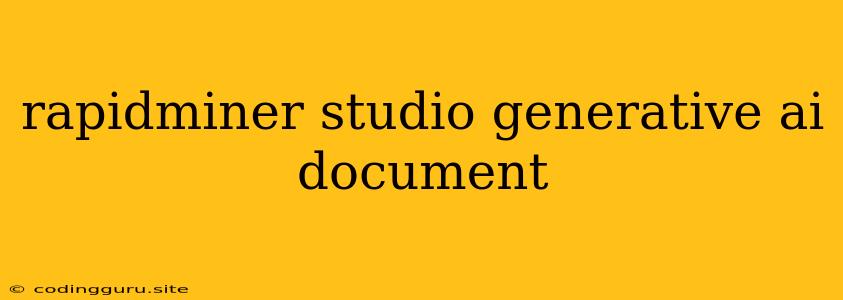Unleashing the Power of Generative AI with RapidMiner Studio: A Guide to Documenting Your Journey
RapidMiner Studio, a renowned data science platform, has embraced the transformative potential of Generative AI. This cutting-edge technology empowers users to generate realistic and coherent text, images, and even code, opening up a world of possibilities for innovation and efficiency.
But how can you effectively harness this power within RapidMiner Studio? And how do you document your journey, ensuring transparency and reproducibility of your generative AI models? This guide aims to equip you with the knowledge and tools needed to navigate this exciting frontier.
Understanding Generative AI within RapidMiner Studio
Generative AI models, trained on vast datasets, learn patterns and relationships within the data. This enables them to generate new outputs that resemble the training data but are original and unique. Within RapidMiner Studio, these models are readily accessible through various operators, allowing you to seamlessly integrate Generative AI into your workflows.
Key Questions:
- What types of generative AI models can be used in RapidMiner Studio? RapidMiner Studio supports various Generative AI models, including text-to-image models (e.g., Stable Diffusion, DALL-E 2), text-to-text models (e.g., GPT-3, Jurassic-1 Jumbo), code generation models (e.g., Codex), and others.
- How are these models integrated into RapidMiner Studio workflows? RapidMiner Studio provides operators that allow you to easily connect, configure, and execute these models, enabling you to incorporate them seamlessly into your data science projects.
Documentation: A Crucial Element for Success
Documenting your work with generative AI is essential for several reasons:
- Reproducibility: A well-documented workflow allows others (or you in the future) to replicate your results and build upon your work.
- Transparency: Clear documentation demonstrates the process behind your generative AI models, fostering trust and accountability.
- Collaboration: A shared understanding of your model development process facilitates collaboration with colleagues and stakeholders.
Documenting Your Generative AI Journey in RapidMiner Studio
Here are some key aspects to document:
- Dataset: Describe the dataset used for training the Generative AI model. Include details about its source, size, format, and any pre-processing steps.
- Model: Specify the chosen Generative AI model, its architecture, hyperparameters, and training configuration.
- Results: Present the outputs generated by the model, including text, images, code, or any other relevant formats.
- Evaluation: Include metrics used to assess the model's performance and interpret the results.
- Challenges: Document any challenges encountered during the development process and the solutions adopted.
Tips for Effective Documentation:
- Use a consistent format: Employ a standardized documentation format, such as a Jupyter Notebook, Markdown file, or RapidMiner Studio's built-in reporting features.
- Provide clear explanations: Describe the rationale behind each step in your workflow and the expected outcomes.
- Include relevant visuals: Use images, graphs, and charts to illustrate your findings and make your documentation more engaging.
Examples of Documentation in RapidMiner Studio
- A Jupyter Notebook documenting a text-to-image model used to generate images based on textual descriptions can include code snippets, visualizations of generated images, and commentary explaining the process.
- A RapidMiner Studio report showcasing the results of a code generation model can present the generated code alongside metrics measuring its quality and efficiency.
Beyond Basic Documentation
For advanced documentation, consider the following:
- Version control: Use a version control system (e.g., Git) to track changes in your project and collaborate effectively.
- Model explainability: Explore techniques to understand the reasoning behind the model's outputs, enhancing its transparency and trust.
- Model governance: Establish a framework for managing and monitoring your Generative AI models throughout their lifecycle.
Conclusion
Documenting your work with Generative AI in RapidMiner Studio is crucial for reproducibility, transparency, and collaborative success. By following these guidelines, you can effectively capture your journey, enabling you to share your insights, enhance accountability, and contribute to the advancement of Generative AI applications.
